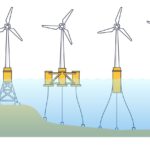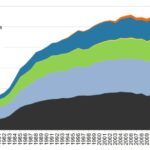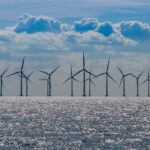Gisteren schonk Jan Jacobs aandacht aan de Amerikaanse ecomodernist Mike Shellenberger.
Onder de titel, ‘A question that gives pause: If Solar And Wind Are So Cheap, Why Are They Making Electricity So Expensive?’, schreef Shellenberger onlangs een ‘posting’ voor WUWT. Ik pik er een aantal alementen uit.
Over the last year, the media have published story after story after story about the declining price of solar panels and wind turbines.
People who read these stories are understandably left with the impression that the more solar and wind energy we produce, the lower electricity prices will become.
And yet that’s not what’s happening. In fact, it’s the opposite.
Between 2009 and 2017, the price of solar panels per watt declined by 75 percent while the price of wind turbines per watt declined by 50 percent.
And yet — during the same period — the price of electricity in places that deployed significant quantities of renewables increased dramatically.
Electricity prices increased by:
- 51 percent in Germany during its expansion of solar and wind energ from 2006 to 2016;
- 24 percent in California during its solar energy build-out from 2011 to 2017;
- over 100 percent in Denmark since 1995 when it began deploying renewables (mostly wind) in earnest.
What gives? If solar panels and wind turbines became so much cheaper, why did the price of electricity rise instead of decline?
Kwam het omdat andere energiebronnen (kolen, kernenergie en gas) duurder werden? Dat bleek niet het geval te zijn. Of omdat kernenergiecentrales werden gesloten? Ook dat bleek niet het geval.
That leaves us with solar and wind as the key suspects behind higher electricity prices. But why would cheaper solar panels and wind turbines make electricity more expensive?
The main reason appears to have been predicted by a young German economist in 2013.
In a paper for Energy Policy, Leon Hirth estimated that the economic value of wind and solar would decline significantly as they become a larger part of electricity supply.
The reason? Their fundamentally unreliable nature. Both solar and wind produce too much energy when societies don’t need it, and not enough when they do.
Solar and wind thus require that natural gas plants, hydro–electric dams, batteries or some other form of reliable power be ready at a moment’s notice to start churning out electricity when the wind stops blowing and the sun stops shining.
And unreliability requires solar– and/or wind–heavy places like Germany, California and Denmark to pay neighboring nations or states to take their solar and wind energy when they are producing too much of it.
Hirth predicted that the economic value of wind on the European grid would decline 40 percent once it becomes 30 percent of electricity while the value of solar would drop by 50 percent when it got to just 15 percent.
In 2017, the share of electricity coming from wind and solar was 53 percent in Denmark, 26 percent in Germany, and 23 percent in California. Denmark and Germany have the first and second most expensive electricity in Europe.
By reporting on the declining costs of solar panels and wind turbines but not on how they increase electricity prices, journalists are — intentionally or unintentionally — misleading policymakers and the public about those two technologies.
That could — and should — change. Reporters have an obligation to report accurately and fairly on all issues they cover, especially ones as important as energy and the environment.
Lees verder hier.






De prijs van energie komt niet tot stand conform de wet van vraag en aanbod, maar wordt door de overheid bepaald. En zeker linkse regeringen blijven maar uitgaan van een zg maakbare samenleving. Dat de werkelijkheid steeds laat zien, dat zulks pure onzin is, wordt niet gehoord door deze mensen. Dus door de terreur van “duurzaam” worden er concurrentievervalsende subsidies gegeven aan o.m. zonne- en windenergie en fossiele brandstof wordt juist extra belast. Of die ijdele politici gaan nog een stapje verder door bv de gasprijs waanzinnig te verhogen en kolencentrales te willen sluiten. Ja de planeet “redden” mag wat kosten.
En dat wordt nog “leuker” als de elektriciteitslevering aanbodgestuurd gaat worden, onvermijdelijk met “hernieuwbaar”.
Dan moet je niet Apeldoorn maar Den Haag bellen of je alsjeblieft de wasmachine mag gebruiken.
“De prijs van energie komt niet tot stand conform de wet van vraag en aanbod, maar wordt door de overheid bepaald.”
Zo een onzin heb ik zlelden gelezen
https://www.eex.com/de/
En natuurlijk kan iedere Duitser zijn eigen leverancier kiezen, er zullen dan ook nauwelijks Duitsers zijn die 30ct kWh betalen (zoals geclaimd) als je een beetje zoekt is er genoeg stroom te koop voor 23ct kWh.
Er zijn verschillende problemen in Duitsland
1. De prijs op de markt is enorm gezakt en aangezien er een garantie prijs is afgesproken wordt er dus meer subsidie betaald
2. Verschillende grote bedrijven hebben succesvol gelobied om gene opslag te moeten betalen, dat wordt dus ook gedragen door de consument
Maar ik begrijp het “links”is fout, “groen” is nog veel vauder
Een goede en goedkope alternatieve oplossing?
Daar kunnen we natuurlijk lang op wachten, de “sceptici”gooien de spulletjes uit de kinderwagen en gaan huilen, alternatieve oplossingen? Ho maar
En nee kernenergie van een nieuwe centrale is nog duurder dan wind en zon.
Geeft niet als je daar voor kiest, maar denk niet dat de stroom prijzen dan zakken
@Heyden
Je kunt dan zelden zo’n onzin hebben gezien maar de vraag is feitelijk in welke wereld leef jij?
Ben je je ervan bewust dat de overheid 75% van de energieprijs bepaalt en opstrijkt? En dan heeft de overheid geen invloed op de energieprijs???
Wederom, in welke wereld leef jij????
Oh Rob,
“Ben je je ervan bewust dat de overheid 75% van de energieprijs bepaalt en opstrijkt?”
Uhm, nee dat klopt alleen voor de klein verbruikers, en dat geld dus niet voor de stroomprijs of de grootverbruikers. ook de energieleveranciers zitten er nog tussen en kunnen hun eigen marges bepalen.
Dus je zit er 80% naast
“En dan heeft de overheid geen invloed op de energieprijs???”
Dat was natuurlijk niet wat Pieter stelde (of ben je een stopopje aan het bouwen? )
@ van der Heijden:
Waar ik in ieder geval NIET naast zit is dat die zogenaamde kleinverbruiker wel de hele rekening betaalt van deze veronderstelde energietransitie, en voor zover de zogenaamde grootverbruikers een heel klein beetje meebetalen dan zullen ze niet aarzelen dit 100% weer te verhalen op de consument en dan zijn we weer bij het gegeven dat die kleinverbruiker GROOT mag betalen.
Ja rob je hebt gelijk
Blijft het feit bestaan dat Pieter iets heel anders zij en dat jij dus een stropop hebt gebouwd
En nee je weet niet of de prijzen 100% worden doorbelast er is nog zo iets als export
Dat je ook al geen verstand hebt van economie, is nu ook duidelijk geworden. Waarvan wel blijft onduidelijk.
“Duurzaam” wordt nog duurder! En waarom worden de energieprijzen dan nog hoger?
Na de propaganda deze week op de NPO/RADAR mochten ook de positivo’s van de geothermie / warmtepompen bijna kritiekloos los in de papieren Elsevier van deze week.
Over de progressief stijgende “duurzame” eco-kosten /-lasten werden geen noemenswaardige bezwaren geopperd, het is immers “goed voor het klimaat”, zo wordt aanhoudend beweerd. Wel werd verrassend de beperking aangestipt, dat na maximaal 10 ~ 15 jaar de warmtebron elders moet worden aangeboord, omdat door het terugstromende koude water de bron geen voldoende warmte rendement meer geeft. Wat wordt de EROEI?
Frappant is dat “duurzame” geothermie de zelfde methode van boren nodig heeft als het zo door de milieubeweging verfoeide fracking van gas en olie. Het is opvallend inconsequent van de milieubeweging die propaganda verspreid voor de geothermie methode om “duurzame” aardwarmte te pompen geheel niet op weerstand stuit en fracking wél. Zowel bij warmte pompen als gas en olie fracking kan het grond-/drinkwater vervuilen, bijvoorbeeld door lekkende boorgaten tijdens het pompen.
Bij fracking is al lang door de praktijk weerlegd, dat de door de milieubeweging aanhoudend beweerde zware giftige chemicaliën geheel niet nodig zijn, maar deze pernicieuze giftige mythe wordt nog immer gesubsidieerd hoog gehouden door de milieubeweging, want ze willen uitsluitend “duurzaam”. By Jove, wat een gel..!
En zo streven we politiek naar de invoering van de volgende “duurzame” energie dwaling, die geheel niks voor de klimaatbeheersing doet en ons land economisch aantast. Die 800 miljard ece-kosten bij 0.0003 grC eind 21ste eeuw moet kost wat kost gehaald worden.
Naar de prognoses kijkend is er géén energie-transitie, maar een geld-transitie van welvaart en inkomen door eco-kosten/-lasten van de consument / arme zwoegers naar de klimaat-alarmistische beleggers / rijke “klimaat”-investeerders.
Met dank aan het alarmistische-academisch-klimaat-milieu-industrieel-complex!
Ik denk dan bij geothermie de hoeveelheid chemicaliën die gebruikt wordt een stuk groter is als bij fracking. Bij geothermie wordt gedurende de hele levensduur een behoorlijke hoeveelheid aan corrosie-inhibitors en anti-scaling stoffen toegevoegd aan de warmwaterstroom om ervoor te zorgen dat de pijpen en de de warmtewisselaars niet verstopt gaan zitten met silica-aanslag. Verder draait de gemiddelde geo-thermie put op 75% subsidie en 25% wordt terugverdiend door uitgespaard gasverbruik.
D.H. , interessant voor je: http://www.henkleenaers.nl/nrc21.htm
Het idee dat de richting van de NL overheid ( links, rechts) veel met de hoogte van de energieprijs van doen heeft, behoeft correctie. Het klopt dat de grootverbruikers permanent ten koste van de burgers voor getrokken worden. Naar verhouding evenveel particuliere miljonairs die de HRA (Hypotheek Rente Aftrek) gemaximaliseerd hebven en maximaal vast gezet, worden door de 33% hogere energietransitie prijs (dan rekrnkundig nodig was om de werkelijke meerkosten vd energietransitie terug te kunnen halen) uit de brand geholpen mocht ‘ het aardgasverjubelen door 0,24% vd bevolking, maar met 50% van de totale HRA opbrengst’ wegens stopzetting aardgaspompen in Slochteren opeens nodig zijn.
Hier de dagelijkse prijzen en bronnen van opwekking in Duitsland: Agora meter.
https://www.agora-energiewende.de/service/aktuelle-stromdatenagorameter/chart/conventional_power_generation/20.05.2018/23.05.2018/
Veel negatieve commentaren maar geen oplossingen, daar wordt het niet beter van. Als samenleving, wereldwijd, moeten we een andere richting uit voor energie. Overheidsinmenging in prijzen en andere maatregelen is sturing. Dat je stuurt wil nog niet zeggen dat je er al bent, sluit hobbels niet uit en regelmatig moet je halverwege je richting nog wat bijstellen. In Duitsland zijn subsidies op zonnepanelen gestopt, en op batterijen gestart. Lokale energie opslag haalt de angel uit die prijsverhogende werking van asynchrone opwekking en verbruik. Ook bestaan er andere manieren van warmte opslag/winning dan de grond.
Fons, je hebt gelijk. Het is inderdaad altijd heel gemakkelijk om kritiek te geven. Goed uitgewerkte alternatieven, die lees je hier niet. Alles wat de overheid doet, dat is verkeerd – in de ogen van velen die hier reageren. Maar wat er wel moet gedaan worden, hoeveel dat echt gaat kosten, wat dat jusit gaat oplossen, welke termijnen, welke andere problmeen, dat mees je hier niet! Zo werkt populisme niet!
@Fons 23 mei 2018 om 07:38
Het gaat om de energiedichtheid.
Een liter lucht met een snelheid van 100 km/uur levert minder energie dan een stilstaande liter fossiel.
“Groen” denkt daar anders over (in de trant van “maakbare natuur en natuurwetten”) en dan stokt de discussie.
Als men de CO2-uitstoot wil verminderen, de klimaatverandering de andere kant op wil sturen en de aarde wil redden dan is “hernieuwbaar” als schieten met een mug op een olifant.
Er worden wel een alternatief aangedragen: kernenergie.
En dan komen de emoties los en worden alle registers opengezet om te benadrukken hoe gevaarlijk dat wel is.
Voor een deel is dat juist: als men de zeer strikte veiligheidsvoorschriften negeert dan gaat het mis.
Een gesmolten zout (thorium) kerncentrale werkte al in de jaren 1960; verdere ontwikkeling werd gestopt OMDAT er geen “weapons grade” bijproduct wordt geproduceerd!
Alle reden dus om de ontwikkeling weer op te starten, zeker als het nu opgeslagen kernafval er ook mee verwerkt kan worden.
Maar ja, decennia propaganda tegen kernenergie zit inmiddels tussen de oren (met dank aan “groen”).
“Hernieuwbaar” helpt niet, dus bestaat er dan wel een klimaatdreiging????
“Een liter lucht met een snelheid van 100 km/uur levert minder energie dan een stilstaande liter fossiel.
“Groen” denkt daar anders over (in de trant van “maakbare natuur en natuurwetten”) en dan stokt de discussie.”
Keurige stropop Boels! Echt een schoonheid, hoe krijg je hem uit de dikke duim gezogen
“Er worden wel een alternatief aangedragen: kernenergie.”
Waarvan de kosten keurig worden vergeten te vermelden, vooral omdat de kosten veel hoger zijn, en wat schijnt een van de problemen te zijn van de “sceptici”de kosten voor al die arme mensen (zie ook de titel van dit stukje) en een laternatief plan is meer dan alleen maar wat roepen en vervolgens klaar (dat is namelijk geen plan)
“En dan komen de emoties los en worden alle registers opengezet om te benadrukken hoe gevaarlijk dat wel is.”
Ik ben bijvoorbeeld niet tegen, James Hanssen is een uitgesproken voorstander van kernenergie, maar nu nog even de kosten.
““Hernieuwbaar” helpt niet, dus bestaat er dan wel een klimaatdreiging????”
Uhm ja, er is een verschil tussen klimaatbeleid en klimaatwetenschap. “Scpetici”klagen over klimaatbeleid, maar wijzen ook de conclusies van de wetenschap af. kijk en dat is natuurlijk een probleem. Dus Boels kom op met een voorstel hoe gaan we om met de kosten van een nieuwe kerncentrale, wie gaat de benodigde centen bijlappen.
https://www.lazard.com/perspective/levelized-cost-of-energy-2017/
Ik stel dat met de kosten van “hernieuwbaar” (ettelijke honderden miljarden, exclusief de aanpassing van het netwerk) de kernenergie bekostigd kan worden.
En dan reken ik de aantasting van natuur en milieu (de inmiddels ondergeschoven kindjes van groen) niet mee.
Maar basaal: het afwenden van de beloofde dreiging mag nauwelijks geld kosten, de gekozen oplossing gaat niet werken.
Òf we worden voor de gek gehouden omdat er geen klimaatdreiging is, òf we worden dubbel voor de gek gehouden met die dreiging èn met “hernieuwbaar” als oplossing.
Boels
Je stelt iets maar de onderbouwing van dat stellen ontbreekt aan alle kanten
Dus je hebt geen plan al zeg je van wel
En de economisch beste
Je houdt ons dus gewoon voor het lapje
En je vergeet te pleiten voor de meest economische wijze van de uitstoot verminderen namelijk een stevige belasting op CO2 uitstoot
Maar Boels doet liever niets en zeurt wat door over de homogenisatie in de Bilt en natuurlijk kernenergie als uiltieme oplossing zonder dat hij aangeeft wie die veel hogere kosten gaat betalen
Wie betaalt de kosten van “hernieuwbaar”?
En de kosten van een CO2-belasting?
En de kosten van energiezuinigheid?
Voorzetje; iedereen met een inkomen beneden 3 maal modaal.
Jan
sinds wanneer maak jij je zo druk om de kosten van energie? Goede energie bron waarmee we duizenden jaren vooruit junnen mag best wat kosten.
Stop zo snel mogelijk met alle groene susidies en investeer in duurzame kernenergie.
@Fons Ik lees: ‘Als samenleving, wereldwijd, moeten we een andere richting uit voor energie. Overheidsinmenging in prijzen en andere maatregelen is sturing.’
Op de eerste plaats: waarom moeten we dit?
Ten tweede: op grond van welke onomstootbare bevindingen wordt de richting bepaald?
Ten derde: waarom zou de Overheid die richting moeten bepalen en niet het vrije marktmechanisme?
Zo maar eens even inbreken in deze discussie. Voor mij staat nog op geen enkele manier vast dat we wat moeten doen, anders dan dat fossiele brandstoffen op den duur opraken. Een transitie is nodig maar het tempo is veel te hoog. Op die manier lopen we voorbij aan toekomstige ontwikkelingen en kunnen we weer afbreken wat we voor veel geld hebben opgebouwd. Dus beperkte windenergie (alleen op zee) en zonnepanelen. Dan het net aanpassen en woningen beter isoleren. Uiteindelijk is het helemaal niet erg dat de atmosfeer iets warmer wordt (als dat al zo is want de laatste jaren koelt die weer af) want warme lucht kan meer water bevatten en dat komt er vanzelf weer uit. En niet alleen in buien! De overstromingen die daarbij horen hebben alleen te maken met het niet aangepast riool en ondoordachte bouwconstructies. Kortom, beetje bij beetje de wereld verbeteren en geen onomkeerbare stappen zetten. En als laatste: Klimaatdeskundige Nijpels waarschuwde in de jaren tachtig al voor het vergaan van onze bossen ten gevolge van de zure regen. Nou, die bossen staan er prima bij, behalve daar waar de mens via de landschappen en Staatsbosbeheer zo nodig vreselijk moet gaan kappen. En als laatste. Duitsland houdt zijn bruinkoolcentrales nog tot 2040 open, dus onze CO2 uitstoot zal niet dalen (alleen rekenkundig).
“fossiele brandstoffen op den duur opraken”, maar wees niet bezorgd, ieder jaar worden nieuwe onontgonnen voorraden fossiel ontdekt: Marktwerking zal de toekomstige energie-uitdaging oplossen en ons bevrijden van gesubsidieerd en laag energetisch “duurzaam” en de verstandige wereld tot Thorium MSR doen overgaan.
Last updated: Friday, May 4, 2018.
https://knoema.com/infographics/smsfgud/bp-world-reserves-of-fossil-fuels
According to the latest BP Statistical Review of World Energy, total global reserves, by fossil fuel, are now:
Coal – 1,139 billion tonnes
Natural Gas – 187 trillion cubic meters
Crude Oil – 1,707 billion barrels
While these volumes may seem large at a glance, at today’s level of extraction and production rates, BP’s estimated proved reserves*, by fossil fuel, would be exhausted as follows:
Coal – year 2169
Natural Gas – year 2068
Crude Oil – year 2066
BP dutifully acknowledges the abundance of factors that could easily alter these projections, but these factors do not alter the global policy imperitive to support sustainable fossil fuel extraction and development. All we need now is to define “sustainable” against ever changing market, political, and social conditions.
We hebben nog wel wat jaartjes om over te schakelen Thorium MSR electriciteit
Vandaag in De Volkskrant: https://www.volkskrant.nl/columns-opinie/laat-de-discussie-over-het-nederlandse-gas-niet-overheerst-worden-door-emoties~bdc299a6/